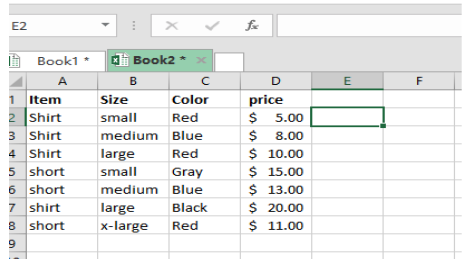

VLOOKUP returns values associated with lookup values in the leftmost column of a table range. VLOOKUP is limited to looking up values that are located in the leftmost column. This feature of looking up a value from within the middle of the table is one of the biggest advantages INDEX/MATCH holds over VLOOKUP. In the second function, MATCH is used to find the row containing the name in column A. In the first function, MATCH is used to find the row containing the state in column C. The INDEX functions are being used to look up the city name by state in the first function and by name in the second function. In this example, the Array is column B, which contains the city names. Using the below table, we will examine two INDEX/MATCH functions.

The INDEX function then returns the value located in the that row of the Array. If the Criteria Range is a column, then the row number within the range will be returned by the MATCH function. The MATCH function looks for the Lookup Criteria in the Criteria Range and then returns its index number. =INDEX (Array, MATCH (Lookup Criteria, Criteria Range, Match Type)) Where Index = MATCH (Lookup Criteria, Criteria Array, Match Type) Since the MATCH function returns an Index number, it can be inserted within an INDEX function in place of the Index parameter. Using INDEX and MATCH together provides for a more robust and versatile lookup function than VLOOKUP, although the formula is a bit longer. The following formula will determine the index or location of C in array A1:Z1: Match Type is 0 for an Exact Match, which is the most commonly used match type. The Lookup Criteria can be entered directly into the formula or it can be a reference to a cell that contains the Lookup Criteria.Ĭriteria Range is a single row or single column of cells where the Lookup Criteria can be found. Lookup Criteria is the value that you want to look for in the Criteria Range. =MATCH(Lookup Criteria, Criteria Range, Match Type) The parameters of the MATCH function are lookup criteria range, criteria range and match type.

In the MATCH function, the cell value is specified as a parameter and the formula returns the Index. In the INDEX function, the Index is specified as a parameter and the formula returns the cell value. It can be helpful to think of Match as a reversed INDEX. MATCH provides a way to return the index number of a value stored in an array. If A1:Z1 were filled with the letters of the alphabet, this INDEX would return the letter C, which is the text in the third cell. The following formula will return the value of the third cell in array A1:Z1: Where Index is a location within the Array.įor an Array with a single row or column, only the row or column number needs to be specified.įor an array with multiple rows and columns, both the row number and column number need to be specified. Parameters of the INDEX function are Array and Index. INDEX returns a value from a range or an array based on its position, or index, in the array. The advantages and disadvantages of these functions are presented below. To make this job easier, Excel offers built in functions for finding information: INDEX, MATCH, and VLOOKUP. AND, you must have the ID number arranged in descending order for both lists for it to be halfway successful.Ī lot of limitations! So let's look at a better solution.Excel users frequently have a need to lookup data in one spreadsheet and use it in another. NOTE THE DOWNSIDE: If there are any repeat numbers in the first column, LOOKUP() will repeat the first record it finds with the information. I can use LOOKUP() to find the call number for each of these with ease using the unique BIB in the first column. Who was who among North American authors, 1921-1939.Īrt education: a guide to information sourcesĮncyclopedia of information systems and services In the following example, the CALLNO was mistakenly left off the copied table: BIB

Using LOOKUP() can populate that column from the first one if a unique ID has been established. We filter this list to distribute it to a group for comment, but forgot to add one column after spending a lot of time preparing the second spreadsheet. LOOKUP() is a good tool for finding specific text from one spreadsheet to another PROVIDED the second spreadsheet is a subset of the first.įor example, let's say we have a spreadsheet of 3000 rows of information.


 0 kommentar(er)
0 kommentar(er)
